December 2018
December 31, 2018
The man who hated double parking
Robert Allan Miller hated double parkers so much that he left money in his will to the city of Bethlehem, PA for a fund that would reward police officers who ticketed double-parked cars.However, the city had to turn down the bequest due to their policy of not giving officers incentives for ticket-writing. (Which surprises me, since I figured municipal police depts used all kinds of ways to encourage officers to write tickets.)

Latrobe Bulletin - Aug 24, 1998
Posted By: Alex - Mon Dec 31, 2018 -
Comments (0)
Category: Law, Police and Other Law Enforcement, 1990s
Follies of the Madmen #403
"We really move our tail for you." Not acceptable today as a slogan?
However, the "Coach Pub" is always in style.
Posted By: Paul - Mon Dec 31, 2018 -
Comments (3)
Category: Innuendo, Double Entendres, Symbolism, Nudge-Nudge-Wink-Wink and Subliminal Messages, Advertising, Air Travel and Airlines, 1970s
December 30, 2018
Sound Bites
Interesting concept, as a gimmick. Though it seems like an impractical way to listen to music, and an expensive way to have a lollipop. No wonder it's no longer being made.
Posted By: Alex - Sun Dec 30, 2018 -
Comments (1)
Category: Toys, 1990s
Beaver-Flavored Booze

Eau de Musc proudly features an old-world flavoring technique that uses the oil extract from the castor gland of the North American beaver, which exudes a leathery, raspberry taste, and acts to fortify the whiskey flavors.
Get yours here!
Posted By: Paul - Sun Dec 30, 2018 -
Comments (5)
Category: Animals, Alcohol, Nausea, Revulsion and Disgust
December 29, 2018
Three men with a pole on their head
February 1976: a performance art group calling itself Ddart walked around the Norfolk countryside for a week carrying on their heads a ten foot pole supported by hats resembling ice cream cones. They called this performance 'Circular Walk.' The UK Arts Council paid them £395 for this.The trio never really explained what the intended meaning of this was, except for the following brief statement later provided by Ray Richards, a member of the group:
More controversial was why the Arts Council had paid for it. John Walker, author of Art & Outrage, provides some details:
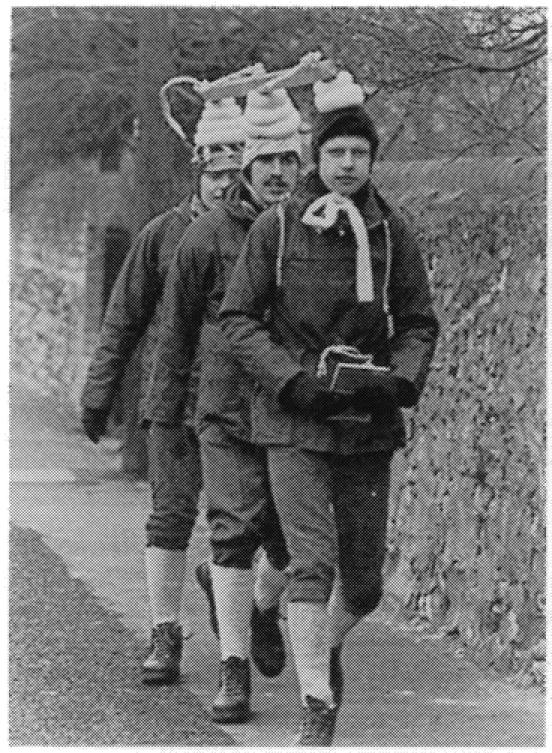
Image source: Art & Outrage
Posted By: Alex - Sat Dec 29, 2018 -
Comments (1)
Category: Art, 1970s
Starcrash
Worst film ever? This blogger makes his case.
Posted By: Paul - Sat Dec 29, 2018 -
Comments (3)
Category: Ineptness, Crudity, Talentlessness, Kitsch, and Bad Art, Movies, Science Fiction, 1970s
December 28, 2018
Mary Connors - The Human Cannonball
Mary Connors is best known for what she failed to achieve. She repeatedly tried to cross the River Avon by being fired across it in a cannon, and she kept ending up in the river.She first tried in 1974, and failed three times in a row. When she then tried to cross the river using a rope and pulley, the pulley jammed, sending her once again into the water.
She tried again in 1976. Once again, she ended up swimming. I think, overall, she made five failed attempts, and never succeeded.
Another highlight of her career was that in 1975 she performed the human cannonball act topless, and she did get that right.
You can watch a video of her first failed attempt at crossing the Avon over at the MACE archive (media archive for central England), but the clip isn't embeddable, so you'll need to actually go to the site to view it.

Mary Connors - 1974
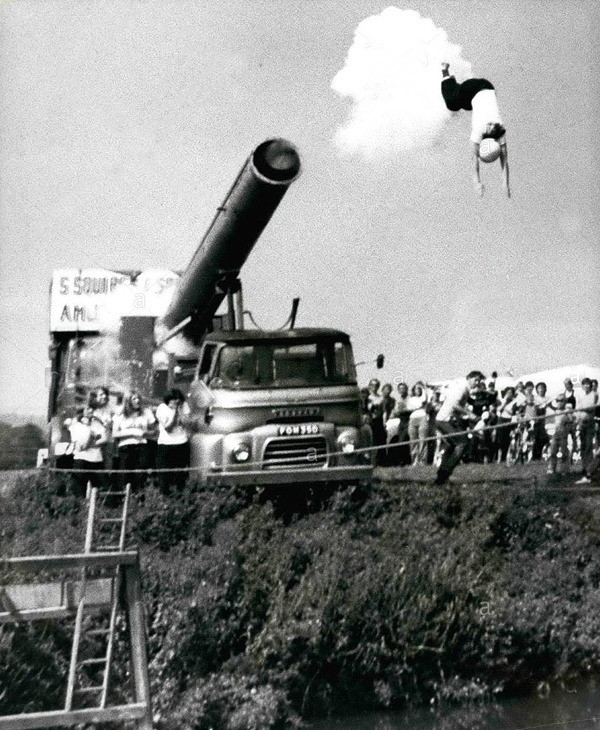
The 1974 attempt
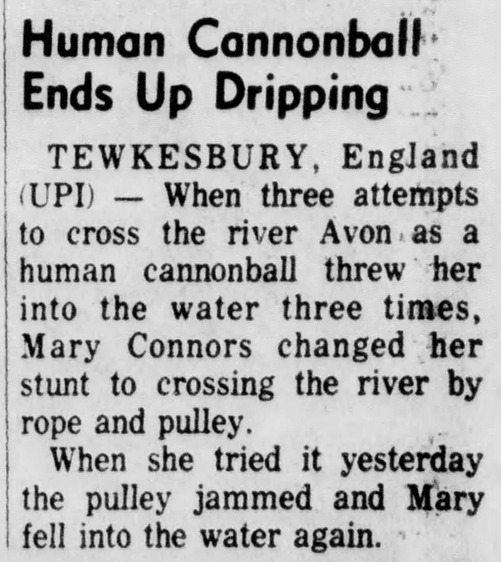
San Rafael Daily Independent Journal - Aug 28, 1974
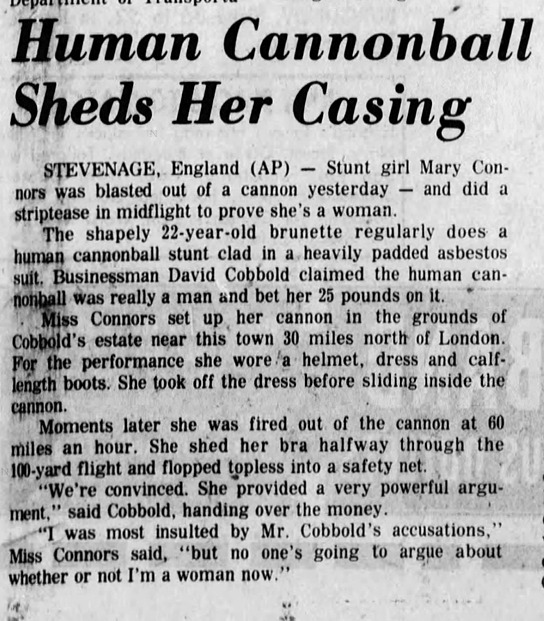
Asbury Park Press - June 6, 1975
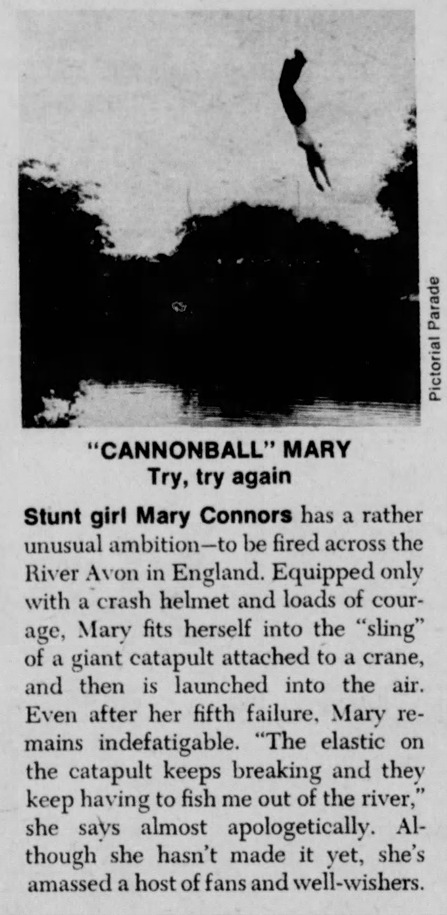
The Bryan Eagle - Jan 25, 1976
Posted By: Alex - Fri Dec 28, 2018 -
Comments (3)
Category: Daredevils, Stuntpeople and Thrillseekers, 1970s
Putnik Ride
It's hard to see what this thing did, other than revolve around the fake Earth. Swing up and down, maybe? I assume there was a counterbalancing capsule on the other end of the boom.Plus, 300 riders per hour? Three in each capsule, as shown. Six total per "ride." That's fifty rides per hour, given filling and emptying the capsules. One minute swinging around at the end of a boom?
Surely one of the dullest rides ever invented.

Source.
Posted By: Paul - Fri Dec 28, 2018 -
Comments (2)
Category: Boredom, Fairs, Amusement Parks, and Resorts, Spaceflight, Astronautics, and Astronomy, 1950s
December 27, 2018
Curiosa
In addition to creating works of his own, artist Barton Lidice Benes collected random, weird stuff, which is detailed in his 2002 book Curiosa: Celebrity Relics, Historical Fossils, and Other Metamorphic Rubbish. Seems like it could be of interest to WUvies! Some of the items include:- Larry Hagman’s gallstone
- a straw used by Monica Lewinsky
- a statue of the Virgin Mary made out of dollar bills
- a penny found in Sigmund Freud’s couch
- a piece of coal from the Titanic
- a cross made out of nails from the Branch Davidian compound in Waco, Texas
- a fork used by actor Steven Van Zandt of The Sopranos
- Gore Vidal’s swizzle stick and coaster
- Art Buchwald’s toothpick
More info: wikipedia, poz.com

Posted By: Alex - Thu Dec 27, 2018 -
Comments (1)
Category: Art, Collectors
Follies of the Madmen #402

Sentient shoe is happy to be ground face-first into floor, so long as floor is shiny clean.
Source.
Posted By: Paul - Thu Dec 27, 2018 -
Comments (1)
Category: Anthropomorphism, Business, Advertising, Domestic, 1950s
| Get WU Posts by Email | |
|---|---|

| Who We Are |
|---|
| Alex Boese Alex is the creator and curator of the Museum of Hoaxes. He's also the author of various weird, non-fiction books such as Elephants on Acid. Paul Di Filippo Paul has been paid to put weird ideas into fictional form for over thirty years, in his career as a noted science fiction writer. He has recently begun blogging on many curious topics with three fellow writers at The Inferior 4+1. Chuck Shepherd Chuck is the purveyor of News of the Weird, the syndicated column which for decades has set the gold-standard for reporting on oddities and the bizarre. Our banner was drawn by the legendary underground cartoonist Rick Altergott. Contact Us |

